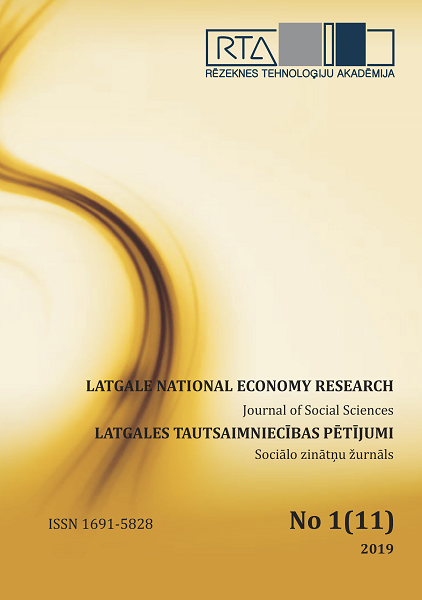Theoretical Aspects of Modern Qualitative Methods for Crisis Management
DOI:
https://doi.org/10.17770/lner2019vol1.11.4366Keywords:
business failure, qualitative prediction methods, the A score modelAbstract
Scientists agree on necessity to predict and timely detect a company crisis that is an integral part of business nowadays. The early identification of a company financial failure due to rapidly changing social, economic and environmental conditions is a topic of growing importance. The sooner a potential financial failure can be identified, the more effective and efficient the anti-crisis measures could be implemented. If a company financial failure could be predicted accurately, it might be possible for the business to be restructured, thus avoiding the failure. This would benefit the owners, shareholders, employees, creditors, and others interested alike.
The modern economic literature provides varied crisis diagnosis methods, mostly based on an analysis of key financial ratios. Less attention is paid to qualitative methods. Therefore, the present research aims to examine modern qualitative methods for company crisis diagnosis (prediction) in crisis management theory.
The research used the theoretical findings of foreign scientists and Internet resources. The research employed the following methods: analysis and synthesis, induction and deduction, the monographic method, document analysis and the graphic method.
The paper provides definitions of main terms related to company failure prediction and a description of general qualitative models of company financial failure (bankruptcy) prediction.
References
Altman, E.I. (1968). Financial Ratios, Discriminant Analysis and the Prediction of Corporate Bankruptcy. The Journal of Finance, Vol. 23, 589–609. Retrieved from https://www.jstor.org/stable/2978933?seq=1#page_scan_tab_contents
Altman, E.I. (1983). Corporate Financial Distress: A Complete Guide to Predicting, Avoiding and Dealing with Bankruptcy. Toronto: Wiley & Sons, 368 p.
Beaver, W.H. (1966). Financial Ratios as Predictors of Failure. Empirical Research in Accounting: Selected Studies, Vol. 4, 71-111. Retrieved from https://www.jstor.org/stable/2490171?seq=1#page_scan_tab_contents
Bunyaminu, A., Bashiru, S. (2014). Corporate Failure Prediction: A Fresh Technique for Dealing Effectively With Normality Based On Quantitative and Qualitative Approach. International Journal of Financial Economics, Vol. 2. (1), 1-12. Retrieved from https://www.academia.edu/7255954/Corporate_Failure_Prediction_A_Fresh_Technique_for_Dealing_Effectively_With_Normality_Based_On_Quantitative_and_Qualitative_Approach
Garcia-Gallego, A., Mures-Quintana, M.J. (2012). Business failure Prediction Models: Finding the Connection between their Results and the Sampling Method. Economic computation and economic cybernetics studies and research / Academy of Economic Studies 3 (3). 157-168. Retrieved from https://www.researchgate.net/publication/286361899_Business_failure_prediction_models_Finding_the_connection_between_their_results_and_the_sampling_method
Genriha, I., Voronova, I. (2010). Maksātnespējas noteikšanas modeļi Latvijas uzņēmumiem. RTU zinātniskie raksti. 3. sēr., Ekonomika un uzņēmējdarbība, (Insolvency Models for Latvian Companies. RTU proceedings. Vol. 3, Issue 8, Economics and Business), (in Latvian), pp. 38-50.
Januška, M. (2002). Firmas finansiāli ekonomiskā stāvokļa analīzes metodika. Praktisks palīglīdzeklis. Rīga: ZKC SIA “Inovācija”, (Methodology for Analysing the Financial and Economic Situation of a Firm. Practical Teaching Aid), (in Latvian), 40 p.
Ncube, T. (2014). Predicting corporate failure. International Journal of Economics, Commerce and Management, Vol. II, Issue 11. Retrieved from http://ijecm.co.uk/wp-content/uploads/2014/11/21130.pdf
Piesse, J., Lee, CF., Kuo, HC., Lin, L. (2013). Corporate Failure: Definitions, Methods, and Failure Prediction Models. Lee CF., Lee A. (eds) Encyclopedia of Finance, 479-490. Retrieved from https://www.scribd.com/document/369794612/48-Chapter-22-Corporate-Failure-Definitions-methods-and-Failure-Prediction-Models
Pogue, M. (2008). Business failure. Prediction and prevention. Retrieved from https://www.accaglobal.com/content/dam/acca/global/PDF-students/2012/sa_jj08_mpogue.pdf
Situ, S. (2013). Business failure prediction models based on expert knowledge. Czech Journal of Social Sciences, Business and Economics, 2 (4), 28-45. Retrieved from https://www.academia.edu/13029000/Business_failure_prediction_models_based_on_expert_knowledge
Šneidere, R. (2009). Finanšu analīzes metodes uzņēmuma maksātnespējas prognozēšanai. Rīga: Lietišķās informācijas dienests, (Financial Analysis Methods for Predicting a Company's Insolvency. Business Information Service), (in Latvian), 232 p.
Zavgren, C. (1989). How a Bankruptcy Model could be Incorporated as an Analytical Procedure. The CPA Journal, Retrieved from http://archives.cpajournal.com/old/07505564.htm
Абалакина, Т.В. (2016). Методы диагностики финансового состояния в антикризисном управлении. Научный альманах, Экономические науки,
N 8-1 (22), (Methods of Diagnosis of the Financial State in Crisis Management. Scientific Almanac, Economics), (in Russian), 24-28. Retrieved from http://ucom.ru/doc/na.2016.08.01.024.pdf
Асаул, А.Н., Князь, И.П., Коротаева, Ю.В. (2007). Теория и практика принятия решений по выходу организаций из кризиса. АНО «ИПЭВ», СПб, (Theory and Practice of Decision-Making on the Exit of Organizations from the Crisis. ANO "IPEV", St. Petersburg), (in Russian), 224 p. Retrieved from http://www.aup.ru/books/m8/5_1.htm
Дорофеев, В.Д. и др. (2006). Антикризисное управление: учебное пособие. Изд-во Пензенского института экономического развития и антикризисного управления, Пенза, (Anti-crisis Management. A Teaching Aid. Publishing House of the Penza Institute for Economic Development and Crisis Management), (in Russian), 209 p.
Дягель, О.Ю, Энгельгардт, Е.О., (2008). Диагностика вероятности банкротства организаций: сущность, задачи и сравнительная характеристика методов. Экономический анализ: теория и практика, 13 (118), (Diagnosis of the Probability of Bankruptcy of Organizations: the Nature, Objectives and Comparative Characteristics of the methods. Economic Analysis: Theory and Practice), (in Russian), 49-57. Retrieved from file:///C:/Users/PC/Desktop/diagnostika-veroyatnosti-bankrotstva-organizatsiy-suschnost-zadachi-i-sravnitelnaya-harakteristika-metodov.pdf
Крюков, А.Ф., Егорычев, И.Г. (2002). Анализ методик прогнозирования кризисной ситуации коммерческих организаций с использованием финансовых индикаторов. Журнал Менеджмент в России и за рубежом, № 2, (Analysis of Crisis Forecasting Techniques for Commercial Organizations Using Financial Indicators. Journal Management in Russia and Abroad), (in Russian). Retrieved from https://www.cfin.ru/press/management/2001-2/krukov.shtml#1_1
Кучер, С.Э. (2016). Методики диагностики кризиса в организации. Экономика и социум, 12 (31), (Methods of Diagnosis of a Crisis in the Organization. Economics and Society), (in Russian). Retrieved from https://iupr.ru/domains_data/files/zurnal_31/Kucher%20S.E.%20-%203%20(Sovremennye%20tehnologii%20upravleniya%20organizaciyay).pdf
Некрасова, А.У. (2016). Антикризисное управление. Учебно-методическое пособие. КГУ им. Н.А. Некрасова, Кострома, (Anti-crisis Management. A Teaching and Methodical Aid. Nekrasov Kostroma State University. Kostroma), (in Russian), 130 p. Retrieved from https://ksu.edu.ru/files/Svedeniya_ob_organisacii/OBRAZOVANYE/Obrazovatelnye%20programmy/38.03.02/MO/Metod_Disc_38_03_02_19_09_16.pdf
Туктарова, T.A. (2018). Диагностика банкротства промышленного предприятия в системе антикризисного менеджмента. Автореферат диссертации, ФГБОУ ВО «Санкт-Петербургский государственный экономический университет», (Diagnosis of Bankruptcy of an Industrial Enterprise under the Crisis Management System. Summary of a dissertation. St. Petersburg State University of Economics), (in Russian). Retrieved from https://search.rsl.ru/ru/record/01008700721


